Gamebox 2.0: Games of November 2022
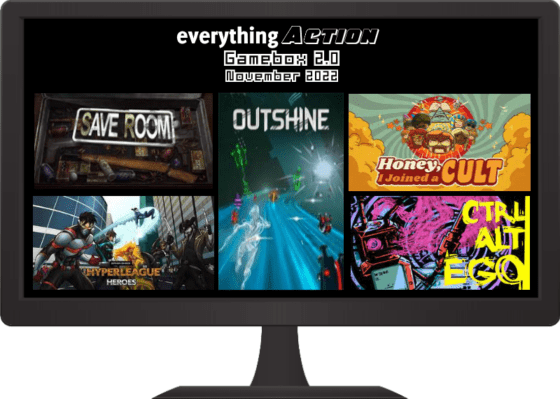
Before we feasted on food, we filled up our gaming plates with some great titles this month. We hopped around robotic control in Ctrl Alt Ego, we used our typing skills for kills in Outshine, and more! Check out the titles we got we played below!
Outshine (Chris): You need quick typing and quick reflexes to shine in Outshine. Developed and published by Fishing Cactus, with support from Plug in Digital Games, Outshine is a fast-paced, arcade-style typing title that challenges players to their keyboard skills. But this isn’t your typical educational game, Outshine focuses on typing as a way of attacking enemies and tossing in a healthy dose of environmental hazards to keep players from getting too comfortable. It blends the frantic pacing of Temple Run, the action focus combat of Typing of the Dead, and a slick presentation all of its own that makes this one of the greatest motivations to improve your typing speeds. Outshine doesn’t simply drop into the gameplay, there is a plot to the game. The story follows a mysterious entity that has broken free from prison and is being assisted by a guardian from afar. Armed with a few fighting abilities and special abilities, it’s up to the player to type up a swarm of words to cut a path to freedom against the hordes of enemies in the way.
The gameplay has two systems that the player to pay attention to. The first is the word prompts that appear in front of enemies. As soon as the letter for one of the words appears, a small countdown begins to see how fast you can finish off the word. The speed, accuracy, and chain combos generate big points. The second thing to look out for is the obstacles in the terrain. Enemies, pitfalls, and blockages will cause damage to the player and must be dodged or destroyed. There are enemy mines that require the player to activate a shield to avoid damage, and it can also be useful to get out of some tough typing situations. It does take some getting used to for all of the to get a quick read of the visual indications and adjust to the speed of the game. But Outshine gives a lot of options to slow down or increase the pace of the game to match a player’s words per min level.
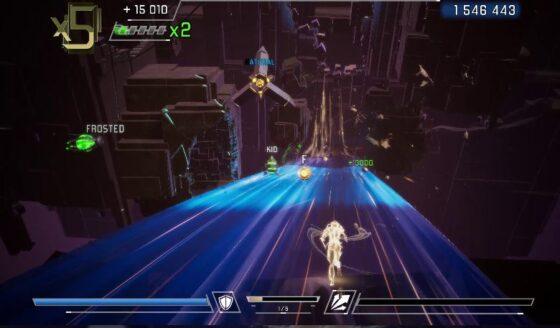
There are also optional perks to enable that give the game a more difficult or easier challenge that can affect the score of the level. There are score multipliers to increase the difficulty like making words fade away after enemies spawn or resetting words after a mistype spelling. If a player wants to showcase their skills, they can attempt to do a perfect run with the option that kills the death with the first mistype word. There are score reductions for changing the rate of recharging abilities or giving temporary invincible. There are also special options that reduce the arcade aspects of the game like making the player totally invincible and adding auto-dodging but at the cost of a nonscorable run.
Outshine has a blend of genres and visuals that makes it look like what happens if The Matrix and Rez merged with Mavis Beacon. The musical score is good and not too distracting while scanning for words and gauging if you can type them in quickly enough. While the plot isn’t something that keeps you around, it is welcomed that the story is mainly told thru the gameplay. The frantic gameplay keeps the player engaged the most and feels rewarding to work towards the more difficult levels. Outshine is a fun and innovative title that stands out from any typical action title. This game is fun for all ages and should give gamers a renewed interest to test their typing skills. Outshine was released on Nov 3rd and is available on Steam.
Ctrl Alt Ego (Chris): Hijack into machines to discover the truth behind the space station in Ctrl Alt Ego. Developed and published by MindThunk, this Ctrl Alt Ego is a first-person adventure “simulator” game that has the player step into the role of digital consciousness where humans have uploaded their brain patterns to bridge the gaps between human and artificial intelligence. Recently awaken, the nameless consciousness program is aided by Dr. Everyman, another consciousness that is trying to stop the Executive, the head program in charge of the space station. A virus is spreading across the space station and the Executive is looking to terminate any rogue programs that fall out of line. Now the nameless program must find a way out of the space station before it’s too late.
The game is similar to a puzzle sim but expands on how you get to figuring out the puzzle mechanics by giving the player a few creative freedoms to find a solution. Ctrl Alt Ego’s main mechanic is hijacking robots and machinery. Throughout the environment, there are various robots and inanimate objects that can take over and can perform certain tasks. From tiny robots that can fit in small spaces, security drones that can break objects, or a camera that can zoom into rooms, there are many robots the player can hop in to reach their goals. But hijacking costs ego points, a type of currency that allows guards robots against being hijacked. Weaker robots cost very few ego points and stronger, more aggressive robotic workers cost more ego. Ego points have to be collected by taking over various objects to absorb their essence. Ego can also be found floating in place or can be taken after a robot has been dismantled.
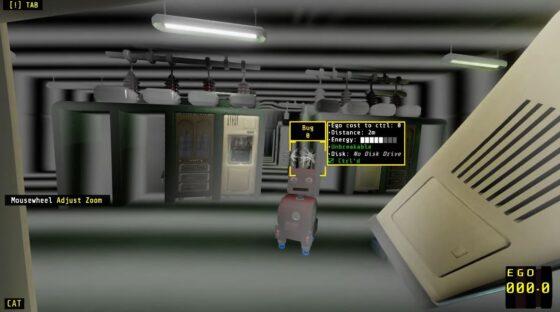
After the initial stage, the player can print out Bug 22, a versatile robot that has attachments and abilities to make it easier to navigate the space. Bug 22’s template can be reused at various locations through the levels, so you can abandon and make new copies whenever you need them. Bug 22 has arms and some weaponry, and special upgrade abilities to configure Bug 22 to hover, generate a shield, and more. However, these abilities cost “juice”, which is fuel for the bug. Juice can be replenished by taking over vending machines and using an ego point to purchase a packet of juice, or sometimes be found laying around. Other robots have their own juice meter and some might need a refill if you wish to use their abilities.
The gameplay follows some sandbox designs that let the player find their own way to solve situations. The environment is meant to be experimented with and tested with creative tools to try multiple methods. You can find easy solutions like reaching certain doors by just hopping into various objects or driving Bug 22 and only hopping when you need to open up a path. Things get a little more exciting when there are patrolling sentries that will try to stop the player and destroy robotic beings on sight if they get too suspicious. Sentries and stronger robots have an awareness factor and will become aggressive to attack under orders from the Executive. You have the option to go guns blazing to make it safe to travel or you can be stealthy and try to go undetected. But choosing the more aggressive acts can lead to some tougher situations where you will need the weaponry of Bug 22 or other robots that you have taken over.
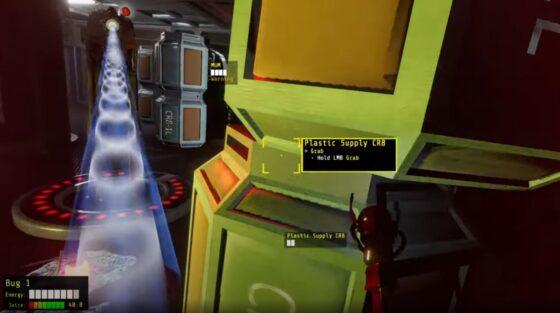
It is too simple to dismiss Ctrl Alt Ego’s depth by the visuals and at times, janky physics. But the game opens up to patient players that explore and examine the atmosphere of the game. The designs of the different game mechanics come thru with minimalistic 3D models and animations. The plot actually gets kind of trippy and is told mostly thru documents found around the station, so players not interested in the plot can skip around it. You can find inspiration from games like Portal and 2017’s Prey scattered around, but it finds its own voice in the gameplay. Ctrl Alt Ego is an interesting indie gem that should not be overlooked and provides some great hours of fun to check out.
Save Room (Chris): Arrange an arsenal of weaponry and items without the hassle of fighting the undead in Save Room. Developed by Fractal Projects and published by Ratalaika Games, Save Room takes direct inspiration and designs from Resident 4’s item management system. This title borrows the concept of organizing effective item placement for a causal and quick puzzle challenge. However, unlike RE4, you can’t simply toss out unwanted items. It will take clever positioning, combining items, and even consuming some food to pack everything tight in one neat box.
Save Room is a linear puzzle game that offers 40 levels of item-organizing fun. The first few levels introduce the game’s simple item placement mechanics then slowly bump up the difficulty by giving the player tighter and more compact grid sizes. The gameplay of Save Room is very simple and only takes a few levels to get the whole concept, even for first-time players that have never played a Resident Evil title before. All items have a certain block formation that takes up a slot in the equipment box, but the size of the placement grid is the real issue. Items can be rotated around to make them easy to place and some items combine. Ammo types can stack and also be loaded into their respective weapons to free up space. Health items can be mixed and also be consumed to heal the player, but there is no urgency or any direct attacks, and it’s used like a cosmetic effect.
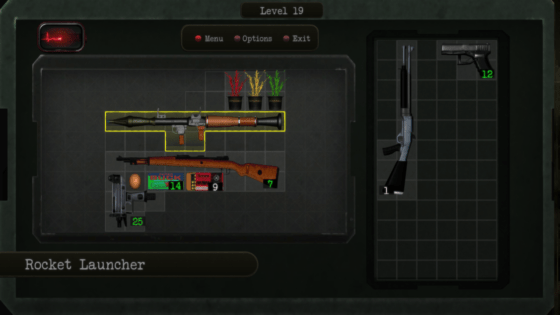
Save Room feels like an old-school flash game that pops up on Newground and is exciting to try for a few hours. It mimics the look and sounds of a RE title without it being an actual game of the series. For what Save Room is focused on, it’s a fun indie game that does exactly what it states and no more. It’s a short title that gets the puzzle parts right but does leave some players like myself wanting a little bit more to the concepts. A dwindling health bar, a grading on effective placement, or randomized items would’ve been interesting designs to include. Save Room is short but sweet for big fans of the RE series and looking for a casual puzzle experience. It might not mesh with everyone, but it will be enjoyable for those players that know how to pack well. Save Room was released for the Switch on November 12 and is also available for PC.
Honey, I Joined a Cult (Zach): Coming from Team17 and Sole Survivor Games, Honey, I Joined a Cult is a tycoon/management game that lets you create your own, wacky 70s cult. The game kicks off in the aftermath of your previous attempt at a cult, which ends with the fed shutting down your compound and arresting your followers. You manage to escape with a briefcase full of cash and decide to try again with a new scam. You can fully customize the look of your cult as well as the “cosmic being” you worship and the holy object your group will worship and there are lots of fun options to make whatever kind of cult you want. The game has a pretty extensive tutorial, which you’ll need because there are a ton of things to keep track of in the game. Each member of your cult has stats and can level up different traits, your leader (basically your avatar) also has traits and can level up, there are all the buildings to keep track of, missions to go on, and research to do, it’s a lot. The amount of stuff you need to keep track of does kind of clash with the breezy, humorous tone of the game, as you can’t really enjoy it at first as you are constantly flipping through menus and making sure you are getting everything up and running properly. Once you get the hang of the mechanics and the various systems, there are a lot of interesting and fun things you can do, like building various “therapies” to scam visitors out of their money or putting on a PR campaign to convince the public and the authorities that your cult isn’t a bunch of dangerous wackos.
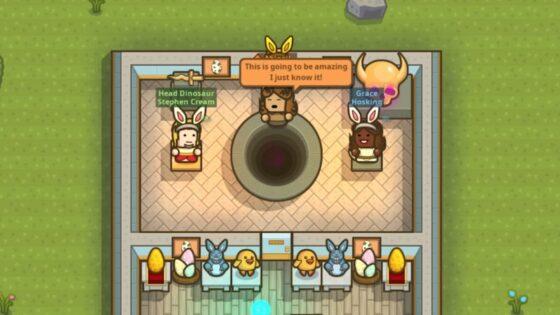
Along with the normal rooms like bedrooms and kitchens, you can build specialized rooms that will help brainwash new members into joining your cult and special rooms where your cultists can worship the object your cult is based around. Your leader also needs to give sermons to keep the message going and keep the faithful involved in the cult. Each cult member is unique and has their strengths and weaknesses, which you need to keep in mind when you are leveling them up. This also ties into missions where you want to send the best person for the job into town. The base building is straightforward and intuitive and there’s a great filtering system for the items you can place in the rooms that will let you get right to the objects you need. You can also search for specific objects and your rooms gain “prestige” and level up depending on what objects you put in the rooms. Despite its goofy exterior, Honey, I Joined a Cult is a hardcore tycoon/management game and there is a ton of things to keep track of. If you are into systems and managing resources, you’ll be right at home in the game. Personally, it was a bit too much for me, even after going through the extensive tutorial and it felt like things immediately started to fall apart as soon as it was over. If you want to check it out for yourself, the game is out now on PC.
HyperLeague Heroes (Zach): Coming from Siphon Shock, HyperLeague Heroes is a superhero-themed dungeon crawler/idle game out now on Steam. You are tasked with assembling a team of warriors to take on the Demon King and his horde of monsters that are threatening the world. You start with a single hero but as you battle and level up, you can recruit new members of your squad from the various enemies you’ve encountered, which is probably one of the most interesting aspects of the game. The more powerful the enemy, the more it costs to recruit them. You delve into dungeons and battle through various floors, facing random enemies every time. The longer you survive, the more dangerous and powerful the enemies become, with every 100 rooms putting you up against a super deadly boss character. Along with the story-based dungeon crawling, you can enter an endless dungeon where you see how long you can last, getting more XP the further you go, and a loot tower, where you can battle and earn equipment for your characters. You can also buy or collect single-use items that you can use in battle and you can fuse characters, which will destroy one but give the other one a trait from the destroyed character, making them more powerful in the process.
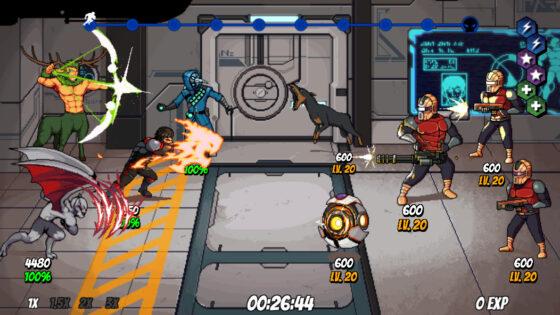
Combat is mostly a passive experience, you can select targets for your characters to fight and you can activate their special abilities but you mostly are just watching them fight and managing your items, using them if you need to wipe out enemies or boost your team. You can crank up the speed up to 3x if you want to get through battles faster and you can even turn on full automation and just have your team fight on their own. It’s a very mobile game-style mechanic and I would much prefer more of an old-school RPG turn-based combat system where you have more agency and can utilize some strategy. The game’s tutorial is also a bit brief, mostly describing what to do in text and there’s almost no explanation for any of the other aspects of the game besides brief text when you first enter the screen. There’s tons of stuff to keep track of and it all seems vital to progressing further in the game, so it’s kind of frustrating when you are just starting with no real idea where to start or what to do. The story mode also, bafflingly, starts at level 20, so you have to grind your characters to at least that level, or maybe even beyond before you can even attempt that mode. One of the main ways you can level up is in the “Dojo”, where you engage in a clicking mini-game where the more you can click in a given time, the more you level up. It’s not that interesting and you have to do it with every character, so you’ll be doing that sometimes more than actually fighting in the main modes of the game. The game’s art style is pretty great, with lots of variety to the characters, who are all represented in some great pixel art and there are some cool comic book-style versions of the character on loading screens and elsewhere in the game and I wish the gameplay was more interesting to better utilize them. Maybe I’m just not properly up to speed on idle games but HyperLeague Heroes was just not up my alley. If this was more of a tactical, turn-based RPG with this theme and art style, I would be all over it, but the grinding and confusing interlocking systems make it a pass for me.



